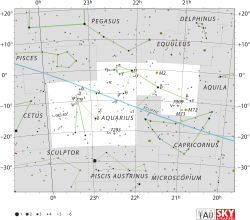Epsilon Aquarii

Location of ε Aquarii (circled) | |
| Observation data Epoch J2000 Equinox J2000 | |
|---|---|
| Constellation | Aquarius |
| Right ascension | 20h 47m 40.55260s[1] |
| Declination | −09° 29′ 44.7877″[1] |
| Apparent magnitude (V) | 3.77[2] |
| Characteristics | |
| Spectral type | A1 V[2] |
| U−B color index | +0.029[3] |
| B−V color index | –0.001[3] |
| Variable type | Suspected[4] |
| Astrometry | |
| Radial velocity (Rv) | –16[5] km/s |
| Proper motion (μ) | RA: +33.98[1] mas/yr Dec.: -34.77[1] mas/yr |
| Parallax (π) | 15.70 ± 0.21[1] mas |
| Distance | 208 ± 3 ly (63.7 ± 0.9 pc) |
| Details | |
| Surface gravity (log g) | 3.64[6] cgs |
| Temperature | 9,470[6] K |
| Metallicity [Fe/H] | +0.07[6] dex |
| Rotational velocity (v sin i) | 70[2] km/s |
| Age | 240[7] Myr |
| Other designations | |
Epsilon Aquarii (ε Aqr, ε Aquarii) is the Bayer designation for a star in the equatorial zodiac constellation of Aquarius. It has an the traditional name Albali and is visible to the naked eye with an apparent visual magnitude of 3.77.[2] The distance to this star can be determined from parallax measurements, yielding an estimated value of around 208 light-years (64 pc) from Earth.[1] Epsilon Aquarii is an A-type main sequence star with a stellar classification of A1 V.[2]
Etymology
This star has an obscure traditional name, Albali, from the Arabic البالع albāli‘ "the swallower". (See also Albulaan.) In the catalogue of stars in the Calendarium of Al Achsasi al Mouakket, this star was designated Nir Saad Bula (نير سعد ألبلع - nayyir sa'd al bulaʽ), which was translated into Latin as Lucida Fortunæ Dissipantis, meaning the brightest of luck of the swallower.[8] This star, along with μ Aqr (Albulaan) and ν Aqr (Albulaan), were al Bulaʽ (البلع), the Swallower.[9][10][11]
In Chinese, 奎宿 (Nǚ Sù), meaning Girl (asterism) (or Woman), refers to an asterism consisting of ε Aquarii, μ Aquarii, 4 Aquarii, 5 Aquarii and 3 Aquarii.[12] Consequently, ε Aquarii itself is known as 女宿一 (Nǚ Sù yī, English: the First Star of Girl / Woman.)[13]
References
- ↑ 1.0 1.1 1.2 1.3 1.4 1.5 van Leeuwen, F. (November 2007), "Validation of the new Hipparcos reduction", Astronomy and Astrophysics 474 (2): 653–664, arXiv:0708.1752, Bibcode:2007A&A...474..653V, doi:10.1051/0004-6361:20078357.
- ↑ 2.0 2.1 2.2 2.3 2.4 Levato, O. H. (August 1972), "Rotational Velocities and Spectral Types of Some A-Type Stars", Publications of the Astronomical Society of the Pacific 84 (500): 584, Bibcode:1972PASP...84..584L, doi:10.1086/129336.
- ↑ 3.0 3.1 Cousins, A. W. J. (1984), "Standardization of Broadband Photometry of Equatorial Standards", South African Astronomical Observatory Circulars 8: 59, Bibcode:1984SAAOC...8...59C.
- ↑ 4.0 4.1 "eps Aqr -- Star suspected of Variability", SIMBAD Astronomical Object Database (Centre de Données astronomiques de Strasbourg), retrieved 2012-06-29.
- ↑ Wielen, R. et al. (1999), Sixth Catalogue of Fundamental Stars (FK6). Part I. Basic fundamental stars with direct solutions (35), Astronomisches Rechen-Institut Heidelberg, Bibcode:1999VeARI..35....1W.
- ↑ 6.0 6.1 6.2 Hill, G. M. (February 1995), "Compositional differences among the A-type stars. 2: Spectrum synthesis up to V sin i = 110 km/s", Astronomy and Astrophysics 294 (2): 536–546, Bibcode:1995A&A...294..536H.
- ↑ Su, K. Y. L. et al. (December 2006), "Debris Disk Evolution around A Stars", The Astrophysical Journal 653 (1): 675–689, arXiv:astro-ph/0608563, Bibcode:2006ApJ...653..675S, doi:10.1086/508649.
- ↑ Knobel, E. B. (June 1895), "Al Achsasi Al Mouakket, on a catalogue of stars in the Calendarium of Mohammad Al Achsasi Al Mouakket", Monthly Notices of the Royal Astronomical Society 55: 429, Bibcode:1895MNRAS..55..429K.
- ↑ Davis Jr., G. A. (October 1944), "The Pronunciations, Derivations, and Meanings of a Selected List of Star Names", Popular Astronomy 52 (3): 12, Bibcode:1944PA.....52....8D.
- ↑ Allen, R. H. (1963), Star Names: Their Lore and Meaning (Reprint ed.), New York: Dover Publications Inc, p. 53, ISBN 0-486-21079-0, retrieved 2010-12-12.
- ↑ ε Aqr as Nir Saad Bula or Lucida Fortunæ Dissipantis (the brightest of luck of the swallower) and the common name is Albali. μ Aqr and ν Aqr was already designated as the common name Albulaan, the plural form of al Bulaʽ
- ↑ (Chinese) 中國星座神話, written by 陳久金. Published by 台灣書房出版有限公司, 2005, ISBN 978-986-7332-25-7.
- ↑ (Chinese) 香港太空館 - 研究資源 - 亮星中英對照表, Hong Kong Space Museum. Accessed on line November 23, 2010.
External links
| ||||||||||||||||||||||||||